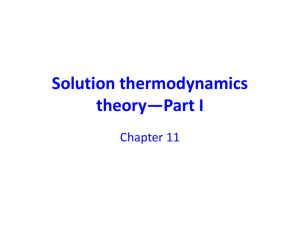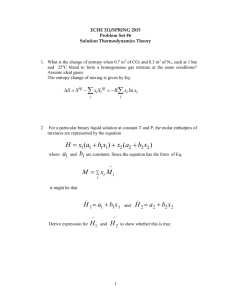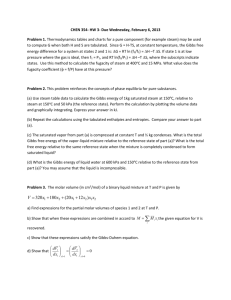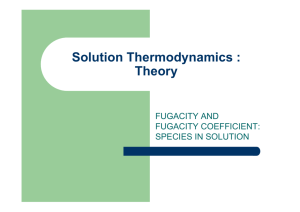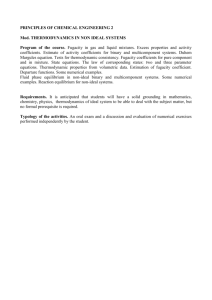Copy of Solution the..
advertisement
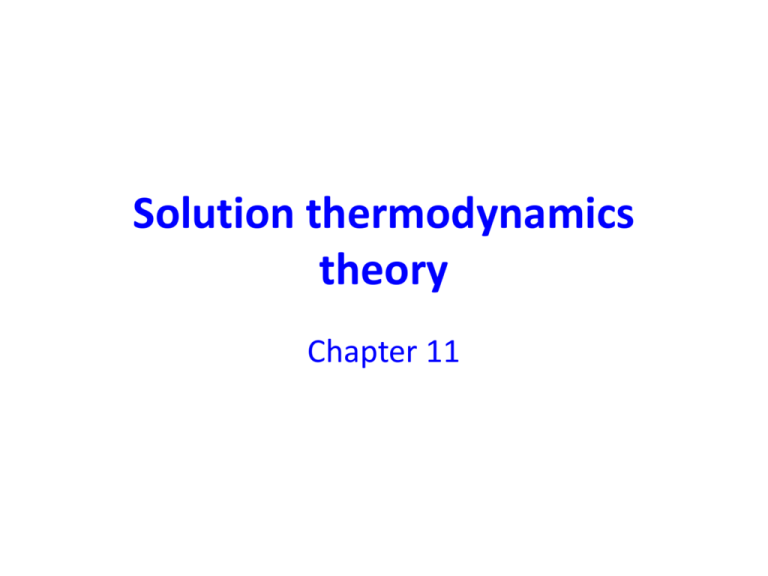
Solution thermodynamics theory Chapter 11 topics • Fundamental equations for mixtures • Chemical potential • Properties of individual species in solution (partial properties) • Mixtures of real gases • Mixtures of real liquids A few equations G H TS For a closed system d (nG ) d (nH ) Td (nS ) (nS )dT from H U PV obtain d(nH) d (nG ) (nV )dP (nS )dT Total differential form, what are (nV) and (nS) Which are the main variables for G?? What are the main variables for G in an open system of k components? G in a mixture (open system) (nG ) (nG ) d (nG ) dP dT P T ,n T P ,n G in a mixture of k components at T and P k d (nG ) (nV )dP (nS )dT i dni i 1 How is this equation reduced if n =1 2 phases (each at T and P) in a closed system Apply this equation to each phase k d (nG ) (nV )dP (nS )dT i dni i 1 Sum the equations for each phase, take into account that (nM ) (nM ) (nM ) In a closed system: d (nG ) (nV )dP (nS )dT We end up with i i dni i dni 0 i How are dni and dni related at constant n? For 2 phases, k components at equilibrium T T P P i i For all i = 1, 2,…k Thermal equilibrium Mechanical equilibrium Chemical equilibrium In order to solve the PE problem • Need models for i in each phase • Examples of models of i in the vapor phase • Examples of models of i in the liquid phase Now we are going to learn about • Partial molar properties • Because the chemical potential is a partial molar property • At the end of this section think about this – What is the chemical potential in physical terms – What are the units of the chemical potential – How do we use the chemical potential to solve a PE (phase equilibrium) problem Partial molar property (nM ) Mi n i P ,T ,n ji Solution property Partial property Pure-species property example (nV ) Vi ni P ,T ,n ji (nV ) Vw nw ~ (nV ) Vw nw lim nw 0 Open beaker: ethanol + water, equimolar Total volume nV T and P Add a drop of pure water, nw Mix, allow for heat exchange, until temp T Change in volume ? Total vs. partial properties M xi M i i nM ni M i i See derivation page 384 Derivation of Gibbs-Duhem equation M M dM dP dT M i dxi P T , x T P , x i M xi M i i Gibbs-Duhem at constant T&P x dM i i 0 constant T & P i Useful for thermodynamic consistency tests Binary solutions See derivation page 386 dM M 1 M x2 dx1 dM M 2 M x1 dx1 Obtain dM/dx1 from (a) Example 11.3 • We need 2,000 cm3 of antifreeze solution: 30 mol% methanol in water. • What volumes of methanol and water (at 25oC) need to be mixed to obtain 2,000 cm3 of antifreeze solution at 25oC • Data: V1 38.63cm / mol V1 40.73cm / mol methanol V2 17.77cm / mol V1 18.07cm / mol water 3 3 3 3 solution • Calculate total molar volume • We know the total volume, calculate the number of moles required, n • Calculate n1 and n2 • Calculate the volume of each pure species Note curves for partial molar volumes From Gibbs-Duhem: x dM i i 0 constant T & P i x1dV1 x2 dV2 0 Divide by dx1, what do you conclude respect to the slopes? Read and work example 11.4 • Given H=400x1+600x2+x1x2(40x1+20x2) determine partial molar enthalpies as functions of x1, numerical values for pure-species enthalpies, and numerical values for partial enthalpies at infinite dilution • Also show that the expressions for the partial molar enthalpies satisfy Gibbs-Duhem equation, and they result in the same expression given for total H. Now we are going to start looking at models for the chemical potential of a given component in a mixture • The first model is the ideal gas mixture • The second model is the ideal solution • As you study this, think about the differences, not only mathematical but also the physical differences of these models The ideal-gas mixture model • EOS for an ideal gas • Calculate the partial molar volume for an ideal gas in an ideal gas mixture For an ideal gas mixture Vi (T , P) Vi (T , P) V (T , P) ig ig and RT pi yi P yi ig V ig For any partial molar property other than volume, in an ideal gas mixture: M (T , P) M (T , pi ) ig i ig i H (T , P) H (T , pi ) ig i ig i dSiig Rd ln P at constant T integrate from pi to P Partial molar entropy (igm) S (T , pi ) S (T , P) R ln yi ig i ig i S (T , P) S (T , pi ) S (T , P) R ln yi ig i ig i ig i Partial molar Gibbs energy Gi ig H iig TSiig H iig TSiig RT ln yi iig Gi ig Giig RT ln yi Chemical potential of component i in an ideal gas mixture ******************************************************************************* RT dG Vi dP dP RTd ln P at constant T P integrating between P 1atm and P ig i ig Giig i (T ) RT ln P This is for a pure component !!! iig i (T ) RT ln P RT ln yi i (T ) RT ln yi P Problem • What is the change in entropy when 0.7 m3 of CO2 and 0.3 m3 of N2, each at 1 bar and 25oC blend to form a gas mixture at the same conditions? Assume ideal gases. We showed that: Siig Siig R ln yi S yi S ig ig i i yi S R yi ln yi ig i i S yi S R yi ln yi ig ig i i i i solution S nR yi ln yi i n = PV/RT= 1 bar 1 m3/ [R x 278 K] S = 204.89 J/K Problem • What is the ideal work for the separation of an equimolar mixture of methane and ethane at 175oC and 3 bar in a steady-flow process into product streams of the pure gases at 35oC and 1 bar if the surroundings temperature Ts = 300K? 1) Read section 5.8 (calculation of ideal work) 2) Think about the process: separation of gases and change of state First calculate H and S for methane and for ethane changing their state from P1, T1, to P2T2 Second, calculate H for de-mixing and S for de-mixing from a mixture of ideal gases solution ig T2 H i Cp (T )dT ig T1 Si ig T2 T1 ig dT P2 Cp (T ) ln T P1 ig H de mix 0 ig S de mix R yi ln yi i ig H yi H i H de mix = -7228 J/mol i ig S yi S i S de mix = -15,813 J/mol K i Wideal = H – Ts S = -2484 J/mol Now we introduce a new concept: fugacity • When we try to model “real” systems, the expression for the chemical potential that we used for ideal systems is no longer valid • We introduce the concept of fugacity that for a pure component is the analogous (but is not equal) to the pressure We showed that: Giig i (T ) RT ln P i i (T ) RT ln( yi P) ig Pure component i, ideal gas Component i in a mixture of ideal gases Let’s define: Gi i (T ) RT ln f i For a real fluid, we define Fugacity of pure species i Residual Gibbs free energy fi G Gi G RT ln P R i ig i G RT ln i R i Valid for species i in any phase and any condition Since we know how to calculate residual properties… G RT ln i R i R i P G dP ln i ( Z i 1) 0 RT P Zi from an EOS, Virial, van der Waals, etc examples • From Virial EOS Bii P ln i RT • From van der Waals EOS bi P ai P ln i Z i 1 ln Z i 2 2 RT R T Z i Fugacities of a 2-phase system G i (T ) RT ln f i v i G i (T ) RT ln f i l i v l One component, two phases: saturated liquid and saturated vapor at Pisat and Tisat What are the equilibrium conditions for a pure component? Fugacity of a pure liquid at P and T v sat l sat l f i ( Pi ) f i ( Pi ) f i ( P) sat f i ( P) Pi sat v sat l sat Pi f i ( Pi ) f i ( Pi ) l Fugacity of a pure liquid at P and T f i ( P) P l sat sat i i 1 exp RT P Pi l V dP i sa t example • For water at 300oC and for P up to 10,000 kPa (100 bar) calculate values of fi and i from data in the steam tables and plot them vs. P * fi 1 1 Hi Hi * * ln * (Gi Gi ) ( Si Si ) RT R T fi At low P, steam is an ideal gas => fi* =P* Get Hi* and Si* from the steam tables at 300oC and the lowest P, 1 kPa Then get values of Hi and Si at 300oC and at other pressure P and calculate fi (P) Problem • For SO2 at 600 K and 300 bar, determine good estimates of the fugacity and of GR/RT. SO2 is a gas, what equations can we use to calculate f = /P Find Tc, Pc, and acentric factor, w, Table B1, p. 680 Calculate reduced properties: Tr, Pr Tr=1.393 and Pr=3.805 High P, high T, gas: use Lee-Kessler correlation • From tables E15 and E16 find 0 and 1 • 0 = 0.672; 1 = 1.354 • = 0 1w 0.724 • f = P = 0.724 x 300 bar = 217.14 bar • GR/RT = ln 0.323 Problem • Estimate the fugacity of cyclopentane at 110oC and 275 bar. At 110 oC the vapor pressure of cyclopentane is 5.267 bar. • At those conditions, cyclopentane is a high P liquid 1 l sat sat f i ( P) i Pi exp RT P Pi sa t l Vi dP Find Tc, Pc, Zc,, Vc and acentric factor, w, Table B1, p. 680 Calculate reduced properties: Tr, Prsat Tr = 0.7486 and Prsat = 0.117 At P < Prsat we can use the virial EOS to calculate isat Pr 0 1 exp ( B wB ) Tr 0.422 1 0.172 0 B 0.083 1.6 ; B 0.139 4.2 Tr Tr sat i isat = 0.9 P-correction term: Get the volume of the saturated liquid phase, Rackett equation V sat Vc Z (1Tr ) c 2/7 Vsat = 107.55 cm3/mol 1 l sat sat f i ( P) i Pi exp RT f = 11.78 bar P Pi sa t l Vi dP Generalized correlations: fugacity coefficient GiR RT ln i P GiR dP ln i ( Z i 1) 0 RT P P Pc Pr ln i Pr ln i Pr 0 0 dPr ( Z i 1) Pr Pr dPr 1 dPr ( Z 1) w Z 0 Pr Pr 0 ln i ln w ln 0 0 ( 1 )w 1 Tables E13 to E16 Lee-Kessler Now we introduce the concept of fugacity for a given component in a mixture • Fugacity of component i in a mixture plays an analogous role to the partial pressure of the same component i in an ideal mixture • At low pressure, the fugacity of i in the mixture tends to be the partial pressure of i. • This means that the fugacity coefficient of i in the mixture tends to 1 at low pressures We showed that: Giig i (T ) RT ln P i i (T ) RT ln( yi P) ig Pure component i, ideal gas Component i in a mixture of ideal gases Let’s define: Gi i (T ) RT ln f i For a real fluid, we define Fugacity of pure species i i i (T ) RT ln( yi P) ig Component i in a mixture of ideal gases Now lets consider component i in solution i i (T ) RT ln fˆi Component i in a real solution Fugacity of component i in solution We can also define a fugacity coefficient of i in solution We can also relate fugacity (in solution) to a residual property M M M R ig M Mi M R i ig i Residual partial Gibbs free energy Gi Gi Gi R ig ˆ f ig i i i RT ln yi P How to calculate fugacity coefficients in solution R ( nG / RT ) ˆ ln i ni P ,T ,n j dP nG / RT (nZ n) 0 P P ( nZ n) dP P dP ˆ ln i ( Z i 1) 0 0 n P P i R P How to calculate fugacity coefficients in solution BP Z 1 RT Valid for mixtures of gases at low and moderated pressures B yi y j Bij i j for a binary B y B11 2 y1 y2 B12 y B22 2 1 2 2 How to calculate fugacity coefficients in solution (nZ i ) Zi ni P ,T ,n j From the Virial EOS (truncated after the second term) P (nB ) Z1 1 RT n1 T ,n 2 You can show that P 2 ˆ ln 1 ( B11 y2 (2 B12 B11 B22 )) RT P 2 ˆ ln 2 ( B22 y1 (2 B12 B11 B22 )) RT Derivation is in page 406, but try to do it by yourself first problem • For the system methane (1)/ethane (2)/propane (3) as a gas, estimate fˆ1 , fˆ2 , fˆ3 and ˆ1 , ˆ2 , ˆ3 at T = 100oC, P = 35 bar, y1 =0.21, and y2 =0.43 1 Bkk yi y j (2 ik ij ) 2 i j ik 2 Bik Bii Bkk P ˆ ln k RT ii 0 ik ki solution 1) Get Tc, Pc, and Vc for each of the components 2) Calculate mixture properties: wij, TCij, PCij, Zcij and Vcij equations 11.70 to 11.74 For example we will have T11, T22, T33, T12, T13, T23 Bˆ ij B 0 wij B1 0.422 1 0.172 B 0.083 1.6 ; B 0.139 4.2 Tr Tr 0 Bij Pcij ˆ Bij RTcij From this equation get Bij that we need to calculate ik For example 13 2B13 B11 B33 Results of in cm3/mol 11 = 0, 22 =0, 33 =0 12 = 30.442, 13 = 107.809, 23 =23.482 P 1 ˆ ln k Bkk yi y j (2 ik ij ) RT 2 i j ik 2 Bik Bii Bkk ii 0 ik ki fˆk ˆk yk P results ˆ1 1.02; ˆ2 0.88; ˆ3 0.78 fˆ1 7.49; fˆ2 13.25; fˆ3 9.76bar When we deal with mixtures of liquids or solids • We define the ideal solution model • Compare it to the ideal gas mixture, analyze its similarities and differences The ideal solution model i i (T ) RT ln( yi P) ig Component i in a mixture of ideal gases That is obtained by using Gi i (T ) RT ln P ig In the first term of this equation Gi (T , P) RT ln yi ig i ig Now we define Gi (T , P) RT ln xi id i id Ideal solution model Other thermodynamic properties for the ideal solution: partial molar volume Gi Gi (T , P) RT ln xi id id Gi P id Vi id V id G T , x P id i xiVi xiVi id i i Vi T partial molar entropy in the ideal solution Gi Gi (T , P) RT ln xi id S id i Gi id T id Giid P, x T R ln xi Si R ln xi P S id xi Siid xi Si R xi ln xi i i i partial molar enthalpy in the ideal solution Gi Gi (T , P) RT ln xi id id H iid Gi id TSiid Gi RT ln xi TSi RT ln xi H i H id xi H iid xi H i i i Chemical potential ideal solution i i (T ) RT ln fˆi Chemical potential component i in a Real solution Gi i (T ) RT ln f i Chemical potential Pure component i Subtracting: For the ideal solution fˆi i Gi RT ln fi i id ˆf id Gi RT ln i fi Lewis-Randall rule i Gi RT ln xi id i id ˆf id Gi RT ln i fi ˆf id x f i i i id ˆ i i Lewis-Randall rule When is the ideal solution valid? • Mixtures of molecules of similar size and similar chemical nature • Mixtures of isomers • Adjacent members of homologous series problem • For the system methane (1)/ethane (2)/propane (3) as a gas, estimate fˆ , fˆ , fˆ and ˆ , ˆ , ˆ 1 2 3 1 2 3 at T = 100oC, P = 35 bar, y1 =0.21, and y2 =0.43 Assume that the mixture is an ideal solution Obtain reduced pressures, reduced temperatures, and calculate k id Prk 0 1 exp ( Bkk wBkk ) Trk ˆf id id y P k k k Results: methane (1) ethane (2) propane (3) ˆ1 1.02; ˆ2 0.88; ˆ3 0.78 Virial model ˆf 7.49; fˆ 13.25; fˆ 9.76bar 1 2 3 1 0.98; 2 0.88; 3 0.76 Ideal solution ˆf id 7.18; fˆ id 13.25; fˆ id 9.57bar 1 2 3 Now we want to define a new type of residual properties • Instead of using the ideal gas as the reference, we use the ideal solution Excess properties M M M E id The most important excess function is the excess Gibbs free energy GE Excess entropy can be calculated from the derivative of GE with respect to T Excess volume can be calculated from the derivative of GE with respect to P And we can also define partial molar excess properties ˆ Gi i (t ) RT ln f i Gi i (t ) RT ln xi f i id subtracting : ˆf i i xi f i Definition of activity coefficient Summary Gi RT ln i R ˆ G RT ln E i i Summary G RT ln yi ig i ig i Gi RT ln xi id i i Gi RT ln i xi HW # 3, Due Monday, September 17 • Problems 11.2, 11.5, 11.8, 11.12, 11.13 HW # 4, Due Monday, September 24 • Problems 11.18, 11.19 (b), 11.21, 11.22 (a), 11.24(a), 11.25
